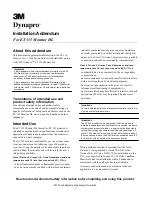
Instruction Manual
D103643X012
DFA Desuperheater
August 2013
7
Figure 4. Fisher AF Nozzle (DFA)
A7191-2D
SPRAY HEAD
SWIRL CHAMBER
WATER INJECTION HOLES
(COMPOUND ANGLED ORIFICES)
PLUG STEM
SPRING
SPRING CASING
PIN
SPRAY PATTERN
SPRAY ANNULUS
TRAVEL MEASUREMENT
DFA Desuperheater Variable Geometry Nozzles
1. Inspect the spray annulus surface, the area between the plug stem and spray head, for excessive wear,
erosion/corrosion, and/or blockage due to particulate. Wear is defined as any nicks, cuts, or gouges on or
immediately around the spray annulus. Erosion/corrosion is defined as any form of rust or erosion of the metal on
the plug stem or spray head. Blockages are defined when small particulate becomes trapped between the plug
stem and spray head or spring casing and spray head. Replacement of the nozzle is recommended if any of the
preceding problems are present.
2. OPTIONAL: Figure 4 shows the spray pattern that will need to be present during operation of the AF nozzles. Testing
can be performed by attaching the existing or an alternate, similar pressure, water line to the unit. If this spray
pattern is not present, replacement is recommended.
3. Grind off the tack welds holding the nozzle in place. Apply a penetrant type thread lubricant and allow to soak prior
to unscrewing the nozzle. Using the provided flats on the side of the spray head, unscrew the nozzle.
4. Grind excess tack weld material off of both the nozzle and desuperheater body.
5. In the absence of external forces, the nozzle must be fully closed. If the nozzle is not fully closed, it will need to be
replaced.
6. Inspect the water injection holes for reduced or non-circular shape due to erosion. Every hole must be the same size
and shape. If any are over
sized or non-circular in shape, the nozzle will need to be replaced.
7. Inspect the interior of the water injection holes for buildup of particulate and/or magnetite. Nozzle replacement will
be needed if any buildup is present.
Note
Complete disassembly of the nozzle is strongly discouraged, due to individual spare parts not being available.
8. OPTIONAL: The internal spring may relax over time and not provide the tensile force required to shut off and control
flow. If the nozzle spring is suspected of being too relaxed, then the nozzle should be replaced.






























